Feature Interview No. 2 with Mike Nuzzo
February, 2006
Mike Nuzzo, of Nuzzo Course Design, LLC, is a golf course architect based in Houston, Texas. His company’s stated goal is to integrate artistry, technical aptitude and business insight into every project. Please refer to Mike’s April 2005 Feature Interview for more information.
1. What’s this new project of yours? Isn’t it supposed to take 10 years for an architect to win his first considerable project?
I’m going to start out slow with a little background information, to help put the end of this answer in context – it is quite exciting for me.
Some business changes – after having been on my own for the past 6 years I recently incorporated and updated my marketing by creating a new website and my first printed and digital brochures. It has been challenging not following a standard apprentice route working for an established firm, and also rewarding as I have been able to develop my own identity and clients. I have been exposed to so many phases and aspects of the business over the years, involvement with so many courses, but I wanted something more comprehensive so I wouldn’t miss a single detail. In 2004 I worked the entire length of a project in the role of associate with my only compensation being my education, which was such a great investment.
More recently I have worked with several existing clubs as clients located in Houston and Fort Worth, TX, Erie PA and Cleveland, OH. Recently I was selected to design a 9 hole course in Utah, and asked to perform routing studies for a public 18 hole course in New Mexico. All of those clients are what I’d call proactive clients. I was making the initiatives, asking where they could use help, visiting to create interest in the projects. I helped move the projects along.
The big news is getting my first new design contract started. It will be an 18 hole private course on the gulf coast near Houston. I say private, it is actually going to be very, very private — a personal golf course. I have so much to do…
Should it have taken 10 years? I don’t know. I do feel like it is a unique opportunity, almost Kidd like.
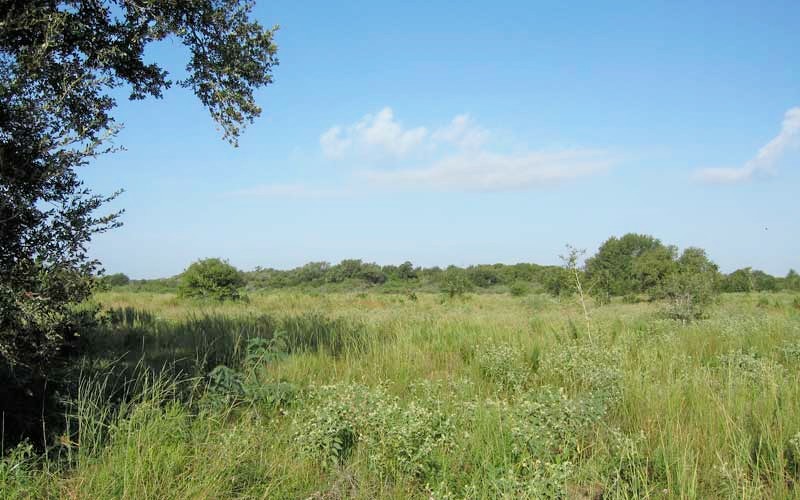
The undisturbed land.
2. What is like getting started?
There have been many fist raising moments in my past. I fondly recall the first time I found I had enough experience to make a transition into the industry. I remember my first of many phone calls with Baxter Spann where he gave me the narrowest of opportunities that burgeoned into a many year relationship. Spann has taught me so much and I am forever grateful for his assistance.
The existing clubs I consult with developed over a longer period of time, so there haven’t been too many heart stopping occasions. Having been selected for a competitive project was thrilling.
The call I got for the personal golf course was the finest thus far. I started talking to this new perspective client, and he asked about my capabilities and style and asked what would be an adequate amount of land for a golf course. I described a few smaller properties, Merion is the go to answer.
I asked “what kind of course do you have in mind, private or public?” His response was that he doesn’t know that many people, so it would be pretty private. It was an unexpected response, so I pressed a little, and he said the golf course would be just for him. Wow!
To my horror, I was about to head on a long business trip and my schedule was so filled, I wasn’t going to be able to meet for about 3 weeks. It was a long, long wait, a very long wait for me.
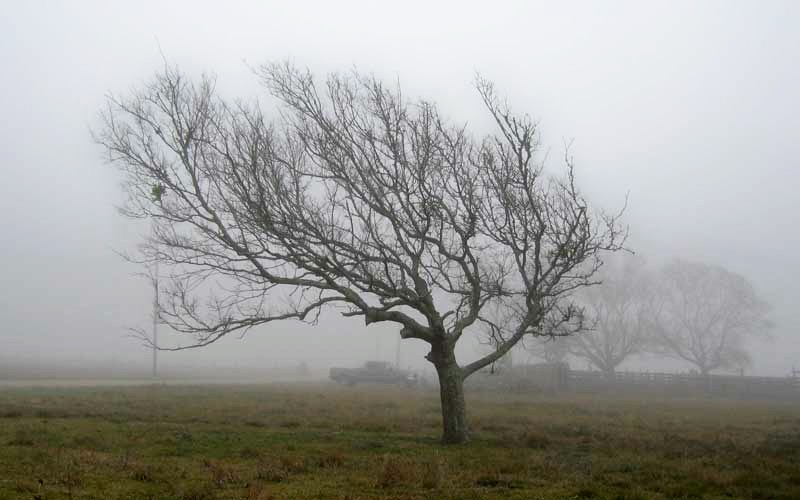
Evidence of the wind
3. What were your first impressions?
My drive to our first meeting was filled with ideas on how I could most cost effectively design an individual course. It was unclear how much property he had to work with… the first parcel of property was 140 acres on the water – but was bordered by a main road and neighboring land to the north and south – it looked nice and would have worked, but as it turned out not to the clients requests. We never toured the bay property that day – we went straight to a larger piece off the same road.
The most affordable ways I considered were some form of pasture golf or maybe a few holes of distinction that could be played in various configurations, like the Sheep Ranch. I was racking my brain thinking of every possible option to eliminate or save. Did he need irrigation? Tees? Rakes? How would it be maintained?
As it turned out, his vision of a private course was completely not what I was expecting.
The client is someone I have the utmost respect for and have already learned from tremendously. I very much look forward to working together. He is very fun too.
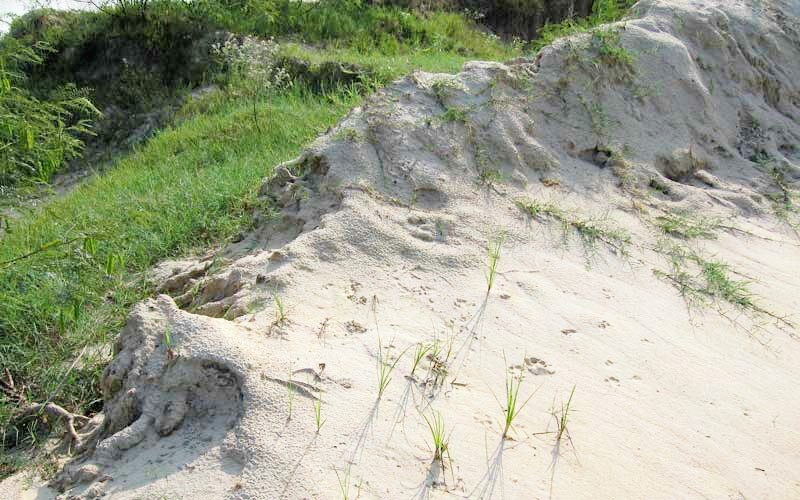
Sand – nature’s gift to golf.
4. Tell us about the site please.
During my first few visits and meetings, it felt like there was a scorecard in my head, listening and looking for clues that would determine the potential for the course.
The property is large and very secluded. It is a very natural or undisturbed environment. There is a creek that bisects the property with significant elevation change. Otherwise the property is generally south Texas flat. It is outside the reach of Houston, and in is a county of a few hundred people.
That first day we visited a separate piece of property that had a sand quarry from which he’d been selling truckloads of sand. He utilizes every square foot of his property. I said I hope he didn’t sell it all, which is when he said he was told he would not run out. Ding, ding – requirement number one – sand.
By his house there is a 400 year old Live Oak that is stunning. He said he only likes Oaks, he hated Hackberry and other trash trees. Any of which on the property would be eliminated. So I heard a bit of a warning buzz that he was a fan of trees. At least if there were some others like this one, they would be quite stunning. The first thing that caught my eye was a small tree that looked like the heat miser caught in a wind storm. Requirement number 2 – wind.
Then we drove through the property and got to the middle where the creek was located. Plenty of elevation change. It had only been one day and the course was already getting significantly better than I had ever envisioned.
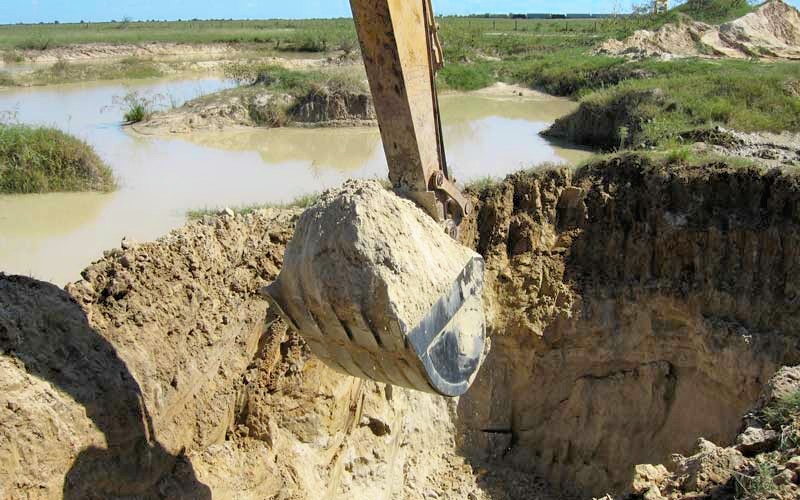
Hummina Hummina……
5. What changed for you after the meeting?
Here were the clients exact words he used to describe the type of course he would like: “I don’t want to loose a ball, I want the course to be difficult, I want the course to be as nice as it can be and I don’t care how long it takes to finish.” I was thankful he didn’t have to pick me up off the ground. I couldn’t have scripted his words more perfectly.
Even though he gave me a general budget for the course, when I left that day I was still figuring how I could make a course for him as affordable as possible. It wasn’t until the next visit that I understood, that as nice as I could make it meant he wanted it as nice as I could make it. I heard that to mean don’t try to skimp or be cheap – Donald Ross popped into my head – and I was going to do my best not to squander any resources. The time factor would take a long time to settle in and be fully appreciated. There are so many instinctive decisions that are based on time factors.
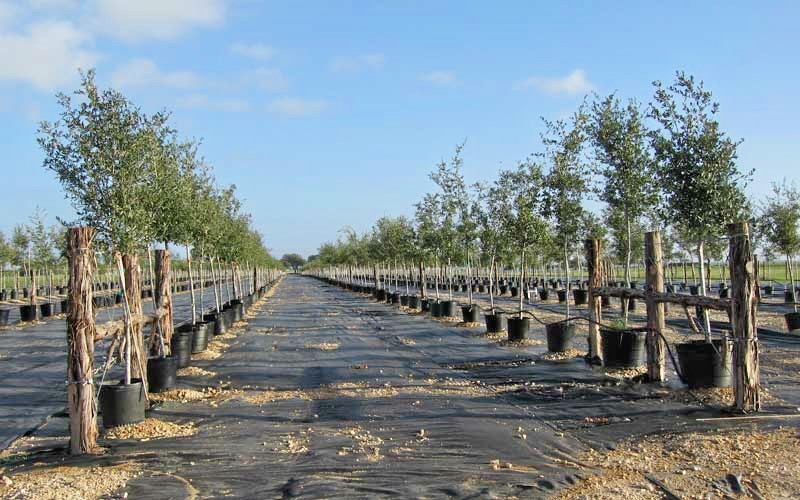
A nursery of Live Oaks.
6. How huge is time as a constraint or rather a non-constraint?
I have already been exposed to so many other constraints: lack of funding, undersized properties, lot premium objectives, environmental hurdles, begrudging local communities, unrealistic managers, malicious clients and impractical opening dates are all substantial limitations. From my experiences time is the one that is always most present and maybe the most influential to the final outcome of the course.
I’ve recently seen courses sodded tee to green. The added expense of almost a million dollars is something this client would rather see used elsewhere or not at all. I’ll have the ability to experiment to get the exact textures I’m looking for in the native areas and around the hazards. Time.
The irrigation system is usually designed for the greatest demands during grow-in. I’ll plan on growing in a few holes at a time and can size the pump station accordingly. Do I really need to irrigate the far roughs? It is nice to have an option, trying to be as efficient as possible. Time.
I am going to be spending a lot of days on site, and I plan to painstakingly work on all the details. Under normal circumstances I would never considered being as involved in the construction.
The following picture is me on a D5. I have wanted to try my hands at field work for some time. I am not just posing up there, I have put hours in practicing and I plan to earn my keep. It is very time consuming and challenging for a beginner to be efficient. Time.
There are so many advantages that I’m just starting to see how many ways time is a most valuable commodity.
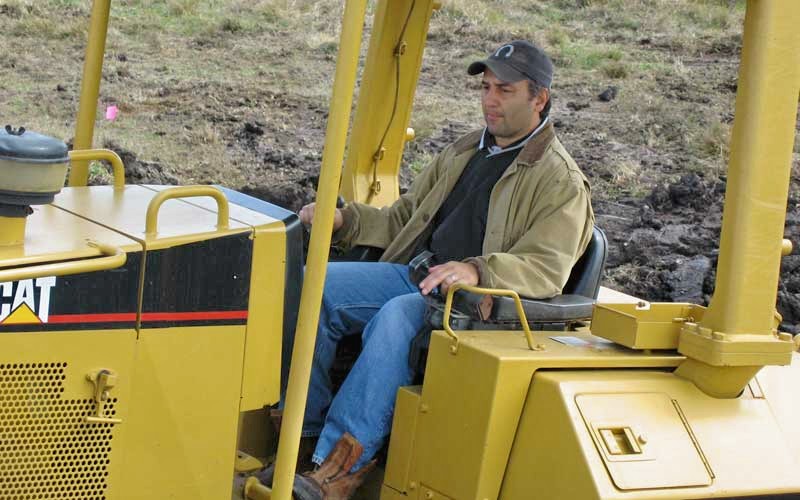
‘Who knew that video games would have been so helpful for my career?’
7. Did you get any unique design criteria, requirements or requests?
For the most part, the client has been allowing me free reign with the golf portion of the layout. So I’ve been most receptive to any requests. There are two that were unique from my experiences: the clubhouse will be a Hurricane shelter, and there needs to be ample room for cattle passage.
My first, of many, routing studies was oriented more north to south, in the same direction as the creek, and yet didn’t take as much advantage of the creek as I had planned. The client liked the layout quite a bit, and this is when I learned he needed more room to allow for cattle passing or grazing north or south of the property. More importantly he said he didn’t want to get too close to the edges of the property… he didn’t want to see any homes from the course. At this point, I was swooning.
One visit was shortly before hurricane Rita was about to make land fall, and he needed to make preparations and tie down his loose ends just in case he was in its path. It was some time after that he expressed a desire to have the clubhouse elevated above the potential storm surge of a category 5 hurricane. That literally translates to high up in the air. He stared off by saying, now I know you won’t like this but… I held back and didn’t ever develop an argument against. I wanted to try first. In the end I made the most of the request as it did add quite a bit of variety to the terrain. I am making the pad as broad as possible and now the 5th hole will play across the edge in very dramatic fashion.
As of today the 5th is my favorite, and most certainly wouldn’t be without his request. It has a little bit of the 17th at NGLA imbued in the design. It is a little longer, and there is more trouble surrounding the green, and I’m greatly looking forward to its development.
Lastly, I have been designing the course to be a walking course. The client has always maintained he’d be riding in the summer heat. I told him he could ride anywhere he wanted, on the greens too if he wished due low volume of anticipated rounds. Recently he suggested he’d like to get several Segways to get around the course in stead of carts. I like his thinking. So my new requirement is to make the course Segwayable too.
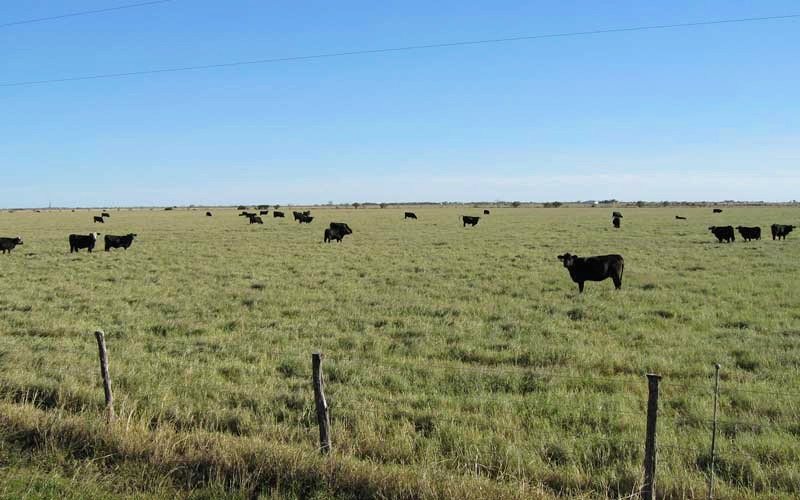
Thankfully the nearby property is only for cattle.
8. How would you describe the routing?
The course plays in a strong wind. Every single hole changes direction from the previous by playing into and with a different angle from the prevailing summer wind. Some changes are subtle, some substantial. The current winter wind is also strong and quite varied from day to day in intensity and direction. It will be a treat every time.
With the creek such a prominent feature of the property I wanted to make sure when finished I didn’t have a creek nine and a plains nine like several courses in the area and that I’ve seen. I wanted to take the approach of some very fine courses that blend and transition their environments in a much more subtle fashion. So the course plays through the plains then heads back to the creek. Then back away towards the lake until the final few holes where the creek is used in dramatic fashion for the finale.
9. You’re building this course for an individual, would the course work if it were public?
I hope so. It is wide open with lots of challenge. There is a great deal of shared fairway space, and I think with the size of the fairways the public could get around safely. The tees would be an area that would need modification. Currently they are going to be tiny and not totally apparent, only small flat plateaus with fairway grass. I am not a fan of mowing lines, and am going to scumble as many lines as possible. There will be a flat spot a few hundred square feet next to many greens that will be the perfect spot to walk off the green and drop a peg and ball, if you must have the peg. The tees next to the greens will be the 6600 yard tees so hopefully that would keep the visiting public from walking to the back tees. I would like to think anyone would enjoy a round on the course, and that the course would endear itself to a player of any ability.
Early on the client had requested a driving range. I asked why. If it were my course I would never be on the range. I’d play the ball down on the first tee and never think of hitting a practice shot ever again. Actually every shot I hit on the course is practice anyway. I designed a huge first fairway with enough teeing space to warm up appropriately.
The clubhouse is not suited for the public. It only has a handful of parking spaces. It would however make a great separate starter house with a clubhouse, range and amenities built on the entrance road.
10. Were you a little concerned about the owner’s stance on trees. Has it evolved?
I wanted to get the course as much to his liking as possible. I was finding the specimen trees, collecting locations of the best. As it would turn out, some areas wound up with no trees once cleared. They were filled with only huisache and hackberries. The routing didn’t require the trees but I did make nice use of some lovely stands of Live Oaks.
One day I was talking in the field with the client trying to get a better gage of his affinity for some trees, when he said the following in response to my question about saving a particular nice tree: “I’d like to stand in the fairway when we are finished and say. Boy I sure am glad we got rid of those trees.”
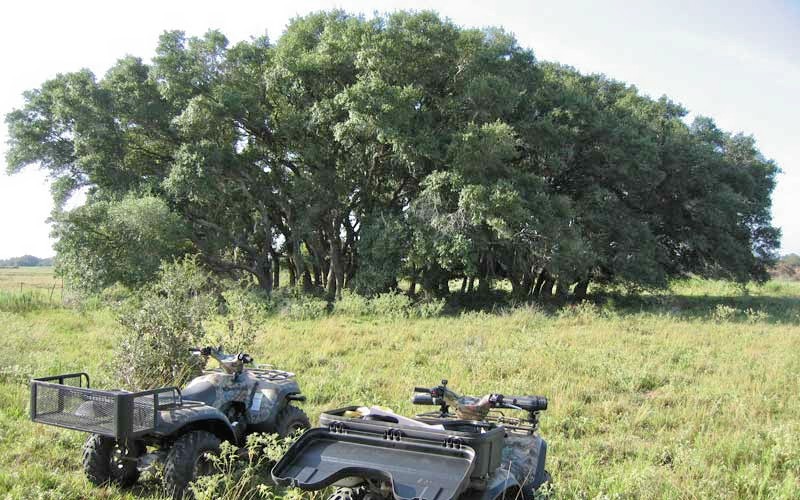
A mott of Live Oaks
11. Have you expanded your role of a designer?
Yes. I’ve been taking on as much responsibility as possible. I’ve positioned myself as someone who has the ability to perform all functions as it pertains to the development of a course. Or at a minimum be able to recommend and oversee with a technical eye, the work of others. My experience supporting the industry has led to a wide breadth of abilities that often will translate to more cost effective solutions for a client. My intent is to be able to respond to a singular request of: “Please make me a golf course” with an authoritative response of being able to deliver everything needed to reach their goal. Surveillance, planning, utilities, roads, cattle pastures, maintenance, superintendent selection, clubhouse and maintenance buildings.
Recently, in my attempt to tackle the vertical architecture, I was contacting clubhouse architects and builders and presenting some findings, when the client brought out a set of plans for a retreat house that was never built. So it was quite fortunate to have a spare set of plans lying around the office. I would say that is highly unusual.
12. What courses have you recently visited to prepare yourself, if any?
My pilgrimages to visit the greatest courses in the world have had no criteria, other than to try and visit as many different architects work and unique sites. One new goal was to see the best courses on flattish property.
Talking Stick North was first. My first reaction was “this course is not flat” and the flattest hole, #2, is one I would never build – in all fairness I played during the wet winter overseed months and it wasn’t very fast and firm which would take away from the course.
Next up was Seminole. I spent a half day walking the course. I was quite surprised with how flat the valley of the course appeared. I couldn’t even tell if it drained. Overall I was less than impressed with the look of the flat portions. I had intentions of using a ridge in play, and may have some of the ocean side ridge come into my thoughts while working in Texas. It was helpful, just not in a way I was expecting. The 16th hole for example, appears to play well strategically, but the look of the fairway and bunkering from the ground does not do the aerial view justice.
Last but not least I am going to St. Andrews in a couple weeks with my father. The Old Course will hopefully be a great inspiration. I’m guessing it is my favorite course in the world. I can’t wait to find out – we’ll be playing backwards too.
13. Have you started a search for a superintendent?
I was having a discussion with the client about the superintendent and his responsibilities. He had just read, in a text, that is was recommended to have the superintendent hired on after the completion of the course so there was a clean line of responsibility and no finger pointing. I suggested the alternative approach of having the super married to the premise of the course from the onset, and how it could be most beneficial. I have also started feeding more appropriate texts for the furthering of his golf architecture education. Having a superintendent intimately aware and of a similar mind set to the ideals of the course will make for a long and healthy future.
Coincidently it was also an architectural book that helped further. This past year I had my first opportunity to have an essay published. It was a treat for me. Paul Daley saved a spot for me in his last addition of Golf Architecture – Volume III. Daley gave me very positive remarks about how he received my essay and he only made a few tiny edits. I was very flattered. I was looking for some additional opinions, because I had learned when young that I wasn’t nimble with a pen, and I wanted to continue to improve. So I started a thread looking for critique in your discussion group.
I got a private message that was rather interesting. It was a superintendent. One who I’d met before and communicated with infrequently through the forum. He was a regular contributor and I thought very knowledgeable. He asked about the methods I described to create my construction documents – since it wasn’t traditional CAD. He had wanted to learn AutoCAD and had even planned for continuing education to augment his abilities. He went so far as to say he would like the opportunity to get more involved in the construction and design process one day. I described my “non-cad” methods and asked him how involved he’d like to get. A few e-mails later and after some open discussions with his family, Don Mahaffey was on a plane from Bend Oregon meeting with me and the client.
Prior to his arrival I went back and had an informal interview with Don – I re-read his old posts, and it didn’t take long before I knew he was our man. My one formal interview question was “How would you effectively maintain a course that only you would play?” I was looking for creativity more than anything else. He was. I hope my search in your forum puts to rest any thoughts about the relevance of Golf Club Atlas to the industry. It was essential for us. Thank you.
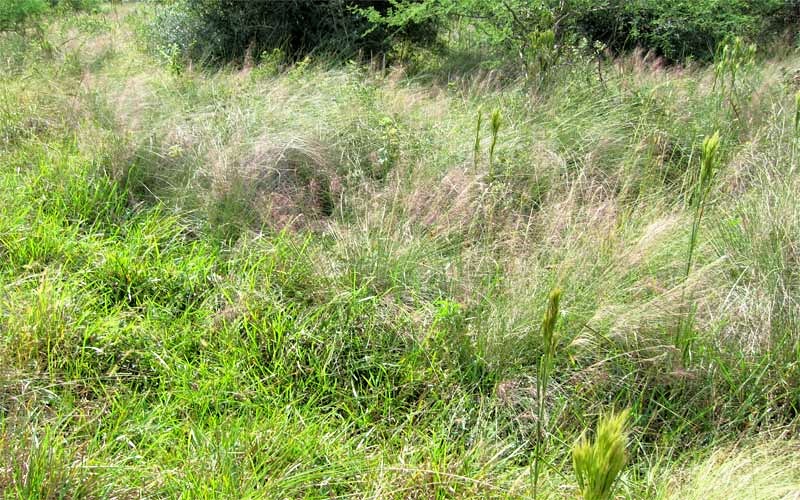
Native grasses.
14. Any different construction methods or how is your R&D coming along?
My favorite new tool is my tablet pc with GPS receiver and antenna. I did draw a great deal of the golf course and have a detailed routing with earthwork and all the drainage and irrigation details to use as a guideline. The resourcefulness of the receiver is to be able to stake quickly and alone. Also the ability to replicate shapes is greatly enhanced. Transferring a complicated shape onto the ground from a traditional construction document is no small task. All the plans are merely a guideline or a starting point for me to work with in the field.
Technically what happens is the following: I’ve laid an image of the course onto an aerial photograph or quadrant that is referenced to a state plane datum – that required about 5 different programs. The receiver communicates with up to 8 GPS satellites giving my location within a few feet on the aerial. When I walk around a small “x” indicates my location and moves around on the screen. It tells me where I am relative to the map or golf course. In just a couple days, with some help, I was able to locate all the greens, tees and turning points as well as flag all the fairways and the lake. It has allowed for a lot more iteration in the field. Clearing has also been greatly accelerated.
As a small note I also learned to use my i-pod for presentations…
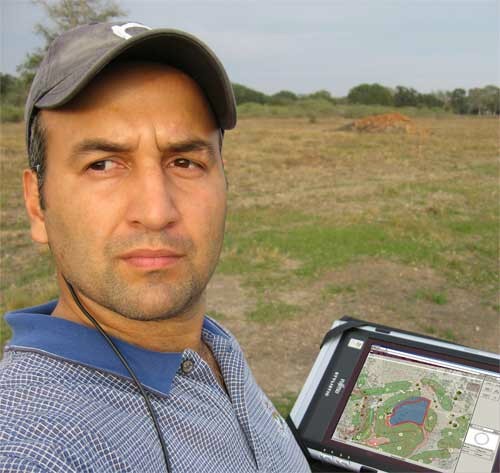
The GPS antenna is under Mike’s hat.
15. What concerns do you have?
I recently heard the basement tapes of some excellent songs. The musicians were clearly talented and the songs were intact and recognizable, but a far cry from what they would eventually become with lots of support like engineering and production.
I feel like I have lots of sound ideas and talent and am looking forward to challenging myself and exploring, but I am aware without proper support the end design or product will be far from refined. There are so many individuals that have helped already. I am welcoming the many more that will help.
From a practical sense there are quite a few critters in the wild. Snakes, spiders, wild hogs, ants, coyotes and lots of big cattle. But I’m most afraid of the bees. I’ve heard they are slightly Africanized. They are quite aggressive when you knock down their homes. Thankfully I’ve only been stung once.
I am also concerned the wind will blow the water from the sprinklers off the golf course. J
16. What setback have you encountered thus far?
This first instance has been quite the roller coaster ride. Bad News: the client owns a company where heavy earth moving equipment is utilized in their core business. It sounded like the client would like to build the course himself. Good News: They only want to do the mass excavations. That was a relief. The crews had been busy clearing and were working great. Then this January a large rain came, which is evidently when they get busy. Bad News: They have been having a banner year since and have been unavailable. I had a golf contractor bid much of the work, but for them it was hard to compete with the internal pricing of the clients company. Worse news: This past week Don and I scheduled a meeting on site with an individual large excavator – he has two large scrapers and a D9. I saw a cloud of dust coming in from the distance getting closer and closer. He pulled up in a 5 ton truck that looked about 75 years old with make shift parts, a radiator bolted to the frame and not much else. I thought it was Mad Max from the Thunderdome. He was nice, but not what we had in mind. Good News: the owner’s company came up with an internal cost basis and coupled with their present demands it was close enough to see the golf contractor back in the hunt.
Initially when the project looked like it was full steam ahead, I had intended on bringing several like minded individuals to help get the ball rolling and try to capture some Pine Valley teamwork magic. There was a small window of opportunity in the winter to get some that were seasonably available. Unfortunately, the windows have closed. Hopefully there will be a chance for future collaboration.
Lastly we had dug several test holes throughout the property, many had struck sand. Some of the native soils tested as loamy sands with up to 80% sand content. Sweet. The sand that was going to cap the course was going to come from the bottom half of the excavated lake. Generally there was a layer of heavy soils covering a six foot band of sand. To utilize the creek the lake would need to be nearby, and unfortunately the soil make up was more than slightly different. The following picture is the first test hole dug at the center of the proposed lake… The shadow is me. In the end we will be getting enough sand, however it clearly won’t be as inexpensive or as accessible as I had hoped.
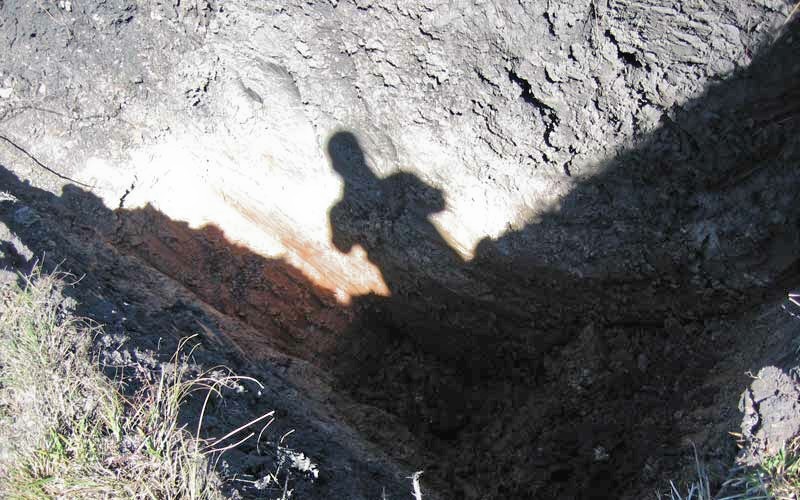
Disappointment!
17. Are you going to work off set plans or design in the field?
I have wanted to design without plans, improvisation in the field for quite some time. Actually ever since I read Tom Doak write about how most architects either use detailed plans or no plans. Not necessarily because it was most apt for the project, but it was the way they learned and were most comfortable. I created some very detailed plans while working with Spann and found the construction process quite efficient. I wanted to be able to do both, and have the project circumstances dictate which method to choose or if I found I was more talented one way, or even use a blended version if appropriate. Would I ever get a more perfect opportunity to design in the field?
Not to say that minimalism is dictated by the non use of plans, it is more indicative of the methodology to create. I did wind up generating an almost complete set of plans for costing and analysis, but I intend to use those as a rough guide at best and add a tremendous amount of detail in the field, primarily the small contours of the fairways and greens. Bill Coore and Doak have been the industry leaders when it comes to improvisation in the field. I will guess that they have more rules and guidelines than almost any other architect working today. It doesn’t just happen by chance, as some would make it seem.
To date I have spent about 25 working days on site, with what would appear to be not a lot to show for my efforts. I am planning for a lot, lot more and in the end it will show, or maybe not in that I hope it will look like it was easy.
18. In your previous feature interview you answered a question about what was lacking in Texas architecture. How will this course be different?
The attribute that Texas has in spades is Wind. And this site is very windy so far, and it will be getting windier. That will lend to very firm and very fast conditions – not entirely unique, but certainly not commonplace. Don will be using irrigation practices that exemplify a fast and firm maintenance meld – deep and infrequent watering with sand capped fairways will create ideal conditions.
Some major differences are that the fairways will be w-i-d-e. As an example the 4th hole landing area is 200 yards wide. The average fairway width is 70 yards – but not its effective width – the fairway targets will be somewhat smaller and there will often be a tortuous path. They will however be very bumpy. I’ll be taking the detailed approach as if every yard of fairway is the green surround. The greens will be varied, contoured and interesting. They will fall in all different directions. Some front to back, some left to right, and some right to left. There will be only two “tees” indicated by a small medallion buried in the ground; 4,500 and 6,600 yards. For the flat bellies and masochists there will be a combination of those two tees that will play much longer. There will even be a little blindness. I’m sure you wouldn’t see a similar course in Texas.
Not just indicative of what is bad in Texas but almost everywhere in the US – What won’t be on the golf course: no cart paths, no ball washers, no trash cans, no tee markers, no yardage markers, no marked sprinklers, no rakes, no satellite controllers and no rough. I did come up with an idea for tee markers for special occasions that will be unusual, and the client ran with an embellishment of his own.
I asked the client if he wanted a home field advantage recently, his reply was a simple yes – some may remember my home field advantage thread. The following are the items that seemed most important: windy, short, fast and firm, deception and psychology, undulated greens and fairways, quirk, lack of information, penal, and small greens.
The other over riding fact of the courses in Texas is they seem to be made for the excellent player and need to be fair. That often translates to many tough par fours around 440 – 460 yards long. This course will be clearly different, depending on your math it looks like we’ll have 7 or 8 half par holes. There are five par 4s below 350 yards and two over 460 yards from the member tees. Finally there will hopefully be many odd bounces that won’t seem fair to some. If and when I see your ball take one of those peculiar bounces, I will have a different opinion.
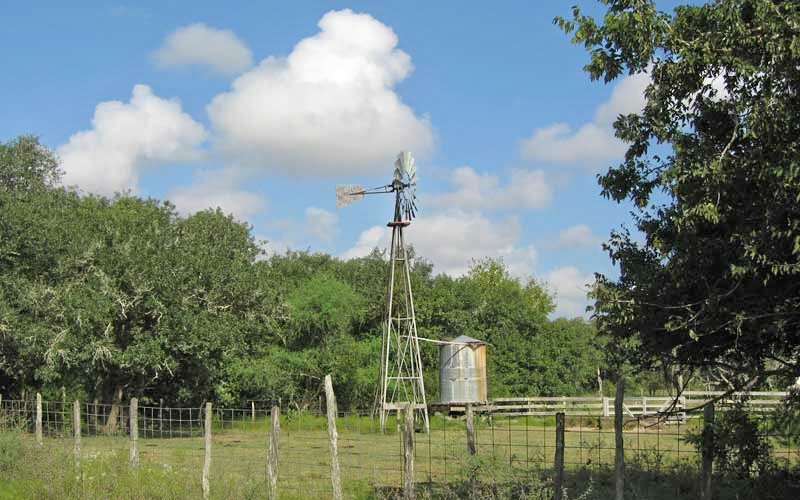
The windmill.
The End







